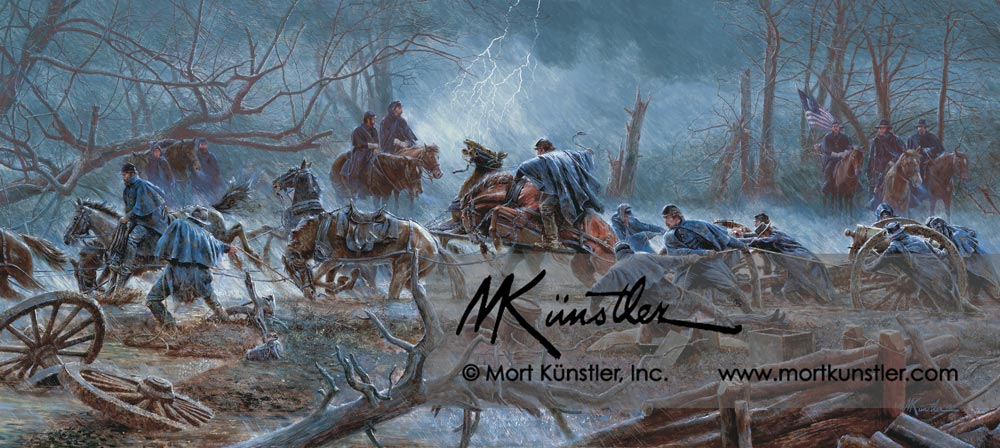Künstler
The Mud March
The Mud March
Couldn't load pickup availability
This is Mort Künstler limited edition print - The Mud March.
Limited Edition Prints
Paper Prints
Reproduction technique: Fine offset lithography on neutral pH archival quality paper using the finest fade-resistant inks.
Each print is numbered and signed by the artist and accompanied by a Certificate of Authenticity.
Image Size: 13½ ” x 30” • Overall Size: 18½” x 34”
Signed & Numbered • Edition Size: 500
Celebrate Virginia Edition • Edition Size: 500
Signed Artist’s Proof • Edition Size: 100
Giclée Canvas Prints
Reproduction technique: Giclées are printed with the finest archival pigmented inks on canvas.
Each print is numbered and signed by the artist and accompanied by a Certificate of Authenticity.
Size: 18” x 40”
Signed & Numbered • Edition Size: 100
Artist’s Proof • Edition Size: 10
Historical Information
By sheer determination, they slogged forward toward the enemy. They were the soldiers of the Union’s Army of the Potomac, and they did not give up. Just weeks earlier, they had been dispatched in wave after wave in an assault on General Robert E. Lee’s fortified line at the battle of Fredericksburg. Their attack had failed, but only due to the misguided leadership by the army’s latest commander, General Ambrose E. Burnside, and not because of any lack of courage by the men in blue.
Now, on January 21, 1863, they were advancing again – as Burnside attempted to flank Lee’s army. The march was conducted in the midst of a brutally fierce winter storm. The weather caused the road to be churned into an ocean of mud. It was “an indescribable chaos of pontoons, vehicles, and artillery,” a Federal officer would later recall – “wagons upset by the roadside, guns stalled in the mud – horses and mules buried in the liquid mud.” Even so, the battle-hardened soldiers of the Army of the Potomac did not give up.
Caissons became mired in the mud. Horses and mules slipped and fell. Driving rain flailed man and beast alike – and yet these men in blue did not yield. Onward they pushed, led by Lieutenant Colonel Joshua Chamberlain of the 20th Maine. They were determined to have another contest with the enemy who had prevailed so many times before. But it would not be here and now. Battle would not come at this time. However, the “Mud March” would become a symbol for this army – a demonstration of endurance, determination and fortitude, as well as inept leadership. On a future field of fire and glory called Gettysburg, the same troops would emerge decisively victorious – due to the same type of courage and grit they displayed in the “Mud March” at Fredericksburg.
Mort Künstler’s Comments
In 2002, Larry Silver of Silver Companies in Fredericksburg asked me if I would be interested in doing a painting of the Army of the Potomac’s famous “Mud March.” Silver Companies own the roadside property along where the march occurred, and are developing it as a unique destination called Celebrate Virginia. Company leaders wanted to preserve the site, and somehow commemorate the “Mud March” as a symbol of the American determination that marked both Southern and Northern soldier in the Civil War. At first I wasn’t very interested in a failed military movement that bogged down in the mud of a winter storm. Then I read Frank O’Reilly’s book, The Fredericksburg Campaign: Winter War on the Rappahannock, which deals in depth with the “Mud March,” and I became intrigued with the topic – both as an expression of the American will and also as a work of historical art. I decided to accept the commission.
The idea of a Civil War painting showing the struggle of man and animal against nature had tremendous potential for drama. I walked and rode through the same muddy roads on Silver Companies’ property used by the Army of the Potomac in the “Mud March” – and I was struck by the incredible hardships that these American soldiers endured. I was also impressed by the power of the storm and the conditions it created – troops struggling against the elements, cannon, artillery caissons and pontoon bridges bogged in the mud, and teams of horses fighting through the mire. Everyone and everything was wet and dirty, and lightning flashes added even more drama to the struggle.
In the painting, Lt. Colonel Joshua L. Chamberlain and his brother, Tom, of the 20th Maine observe from the side of the road in the center background. General Ambrose P. Burnside, commanding general of the operation, is seen in the background on the right side of the painting with members of his staff and his official headquarters flag.
In 2007, the general public will be able to walk along the route of the “Mud March,” as well as see the gun emplacements of the Union army. Thanks to Silver Companies, these Civil War points of interest will be preserved forever. I hope my work will contribute to honoring all Americans of the Civil War generation.
Share


Continue Shopping
See more of the Breagans' collection of manufacturers from all around the world
Subscribe to our emails
Subscribe to our mailing list for insider news, product launches, and more.

